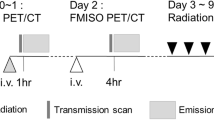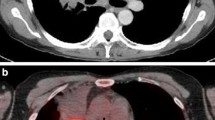Abstract
Objective
This study aimed to characterize clinical outcomes with 18F-fluorodeoxyglucose positron emission tomography (FDG-PET)/computed tomography (CT) scan results at different follow-up time points following stereotactic body radiation therapy (SBRT) for early stage non-small cell lung cancer (NSCLC).
Methods
Records of 83 patients with early stage NSCLC treated with definitive SBRT were reviewed. FDG-PET/CT scans were obtained prior to treatment, at 4 months following treatment, and serially every 6 months thereafter on all surviving patients. The FDG uptake by lesions was assessed visually as the presence or absence of focal abnormal metabolic uptake compared to pretreatment lesions and termed PET-positive or PET-negative, respectively. When available, the maximum standardized uptake value (SUVmax) was calculated to assess semiquantitative values.
Results
No correlation between PET-positive or PET-negative scan at the 4-month time interval and overall survival was observed. The 3-year overall survival for those patients with a PET-negative scan at 10 months was 60.9 % versus a 3-year overall survival of 20.8 % for patients with a PET-positive scan at that same follow-up date (P = 0.001; hazard ratio (HR) = 2.86, 95 % confidence interval (CI), 1.91–12.05).
Conclusion
FDG-PET/CT scans commonly remained positive with focal FDG uptake at 4 months following SBRT; however, this did not always indicate recurrent or residual disease. PET-negative scans at 10 months following SBRT correlated with increased overall survival.







Similar content being viewed by others
References
Siegel R, Naishadham D, Jemal A, Ward E (2012) Cancer statistics, 2012. CA Cancer J Clin 62:10–29
Matsuo Y, Shibuya K, Nagata Y et al (2011) Prognostic factors in stereotactic body radiotherapy for non-small-cell lung cancer. Int J Radiat Oncol Biol Phys 79:1104–1111
Onishi H, Shirato H, Nagata Y et al (2007) Hypofractionated stereotactic radiotherapy (HypoFXSRT) for stage I non-small cell lung cancer: updated results of 257 patients in a Japanese multi-institutional study. J Thorac Oncol 2:S94–S100
Videtic GM, Stephans K, Reddy C et al (2010) Intensity-modulated radiotherapy-based stereotactic body radiotherapy for medically inoperable early-stage lung cancer: excellent local control. Int J Radiat Oncol Biol Phys 77:344–349
Timmerman R, Paulus R, Galvin J et al (2010) Stereotactic body radiation therapy for inoperable early stage lung cancer. JAMA 303:1070–1076
Lo SS, Teh BS, Mayr NA et al (2012) Imaging follow-up after stereotactic ablative radiotherapy (SABR) for lung tumors. J Radiat Oncol 1:11–16
Fischer-Valuck BW, Durci M, Katz SR et al (2013) Influence of patient characteristics on survival following treatment with helical stereotactic body radiotherapy (SBRT) in stage I non-small-cell lung cancer. Thorac Cancer 4:27–34
Dharmarajan KV, Wexler LH, Gavane S et al (2012) Positron emission tomography (PET) evaluation after initial chemotherapy and radiation therapy predicts local control in rhabdomyosarcoma. Int J Radiat Oncol Biol Phys 84:996–1002
Clarke K, Taremi M, Dahele M et al (2012) Stereotactic body radiotherapy (SBRT) for non-small cell lung cancer (NSCLC): is FDG-PET a predictor of outcome? Radiother Oncol 104:62–66
Takeda A, Yokosuka N, Ohashi T et al (2011) The maximum standardized uptake value (SUVmax) on FDG-PET is a strong predictor of local recurrence for localized non-small-cell lung cancer after stereotactic body radiotherapy (SBRT). Radiother Oncol 101:291–297
Satoh Y, Nambu A, Onishi H et al (2012) Value of dual time point F-18 FDG-PET/CT imaging for the evaluation of prognosis and risk factors for recurrence in patients with stage I non-small cell lung cancer treated with stereotactic body radiation therapy. Eur J Radiol 81:3530–3534
Frank A, Lefkowitz D, Jaeger S et al (1995) Decision logic for retreatment of asymptomatic lung cancer recurrence based on positron emission tomography findings. Int J Radiat Oncol Biol Phys 32:1495
Bury T, Corhay J-L, Duysinx B et al (1999) Value of FDG-PET in detecting residual or recurrent nonsmall cell lung cancer. Eur Respir J 14:1376–1380
Zhang X, Liu H, Balter P et al (2012) Positron emission tomography for assessing local failure after stereotactic body radiotherapy for non-small-cell lung cancer. Int J Radiat Oncol Biol Phys 83:1558–1565
Bryant AS, Cerfolio RJ, Klemm KM et al (2006) Maximum standard uptake value of mediastinal lymph nodes on integrated FDG-PET-CT predicts pathology in patients with non-small cell lung cancer. Ann Thorac Surg 82:417–422, discussion 422–413
Matsuo Y, Nakamoto Y, Nagata Y et al (2010) Characterization of FDG-PET images after stereotactic body radiation therapy for lung cancer. Radiother Oncol 97:200–204
Compliance with Ethics Guidelines
ᅟ
Conflict of interest
Lane R. Rosen, Benjamin W. Fischer-Valuck, Michael Durci, Sanford R. Katz, Hsinshun Terry Wu, Amol Takalkar, Mansour Mirfakhraee, and David Lillian declare that they have no conflict of interest.
All procedures followed were in accordance with the ethical standards of the responsible committee on human experimentation (institutional and national) and with the Helsinki Declaration of 1975, as revised in 2008. Informed consent was obtained from all patients for being included in the study.
Author information
Authors and Affiliations
Corresponding author
Additional information
Presented in part as oral presentation at the 54th Annual Meeting of the American Society of Radiation Oncology (ASTRO) in Boston, MA, October 29, 2012 and at the Multidisciplinary Symposium in Thoracic Cancer in Chicago, IL, September 7, 2012
Lane R. Rosen and Benjamin W. Fischer-Valuck contributed equally to this manuscript.
Rights and permissions
About this article
Cite this article
Rosen, L.R., Fischer-Valuck, B.W., Durci, M. et al. Prognostic utility of serial PET/CT imaging following stereotactic body radiation therapy (SBRT) in early stage lung cancer: a single institution experience. J Radiat Oncol 3, 379–386 (2014). https://doi.org/10.1007/s13566-014-0167-2
Received:
Accepted:
Published:
Issue Date:
DOI: https://doi.org/10.1007/s13566-014-0167-2




